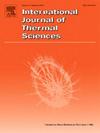Self-guided filtering slow feature thermography for subsurface defect detection in composite materials
IF 5
2区 工程技术
Q1 ENGINEERING, MECHANICAL
International Journal of Thermal Sciences
Pub Date : 2025-06-24
DOI:10.1016/j.ijthermalsci.2025.110077
引用次数: 0
Abstract
Infrared thermography (IRT) is widely used for non-destructive measurement and testing of composite materials and heritage conservation. Thermal data post-processing techniques playing a crucial role in improving accuracy and efficiency. In this work, a self-guided filtering-based slow feature thermography (GF-SFT) method is proposed for subsurface defect assessment of composites. It processes and analyzes time-series thermal imaging data of inspection targets from both temporal and spatial dimensions. First, a self-guided filtering method enhances the thermal image sequence in the spatial domain, preserving critical image features (e.g., edges) while reducing noise and suppressing irrelevant details, thereby improving the data quality. Subsequently, the slow feature analysis technique isolates stable background components in the thermal signal over time while distinguishing rapidly changing features associated with subsurface defects. The proposed framework is validated through an evaluation of filtering performance and a Fourier-based interpretation of fast- and slow-varying thermal features. A test case on a carbon fiber reinforced polymer demonstrates the effectiveness of the GF-SFT method in detecting subsurface defects.
自导向滤波慢特征热成像在复合材料表面缺陷检测中的应用
红外热像仪(IRT)广泛应用于复合材料的无损检测和文物保护。热数据后处理技术在提高数据精度和效率方面起着至关重要的作用。本文提出了一种基于自导向滤波的慢特征热成像(GF-SFT)方法,用于复合材料的亚表面缺陷评估。它从时间和空间两个维度对检测目标的时间序列热成像数据进行处理和分析。首先,自导向滤波方法在空间域中增强热图像序列,保留关键图像特征(如边缘),同时降低噪声并抑制无关细节,从而提高数据质量。随后,慢特征分析技术分离出热信号中随时间变化的稳定背景成分,同时区分与地下缺陷相关的快速变化特征。通过对滤波性能的评估和基于傅立叶的快速和缓慢变化的热特征的解释,验证了所提出的框架。碳纤维增强聚合物的测试案例证明了GF-SFT方法在检测表面下缺陷方面的有效性。
本文章由计算机程序翻译,如有差异,请以英文原文为准。
求助全文
约1分钟内获得全文
求助全文
来源期刊

International Journal of Thermal Sciences
工程技术-工程:机械
CiteScore
8.10
自引率
11.10%
发文量
531
审稿时长
55 days
期刊介绍:
The International Journal of Thermal Sciences is a journal devoted to the publication of fundamental studies on the physics of transfer processes in general, with an emphasis on thermal aspects and also applied research on various processes, energy systems and the environment. Articles are published in English and French, and are subject to peer review.
The fundamental subjects considered within the scope of the journal are:
* Heat and relevant mass transfer at all scales (nano, micro and macro) and in all types of material (heterogeneous, composites, biological,...) and fluid flow
* Forced, natural or mixed convection in reactive or non-reactive media
* Single or multi–phase fluid flow with or without phase change
* Near–and far–field radiative heat transfer
* Combined modes of heat transfer in complex systems (for example, plasmas, biological, geological,...)
* Multiscale modelling
The applied research topics include:
* Heat exchangers, heat pipes, cooling processes
* Transport phenomena taking place in industrial processes (chemical, food and agricultural, metallurgical, space and aeronautical, automobile industries)
* Nano–and micro–technology for energy, space, biosystems and devices
* Heat transport analysis in advanced systems
* Impact of energy–related processes on environment, and emerging energy systems
The study of thermophysical properties of materials and fluids, thermal measurement techniques, inverse methods, and the developments of experimental methods are within the scope of the International Journal of Thermal Sciences which also covers the modelling, and numerical methods applied to thermal transfer.
 求助内容:
求助内容: 应助结果提醒方式:
应助结果提醒方式:


